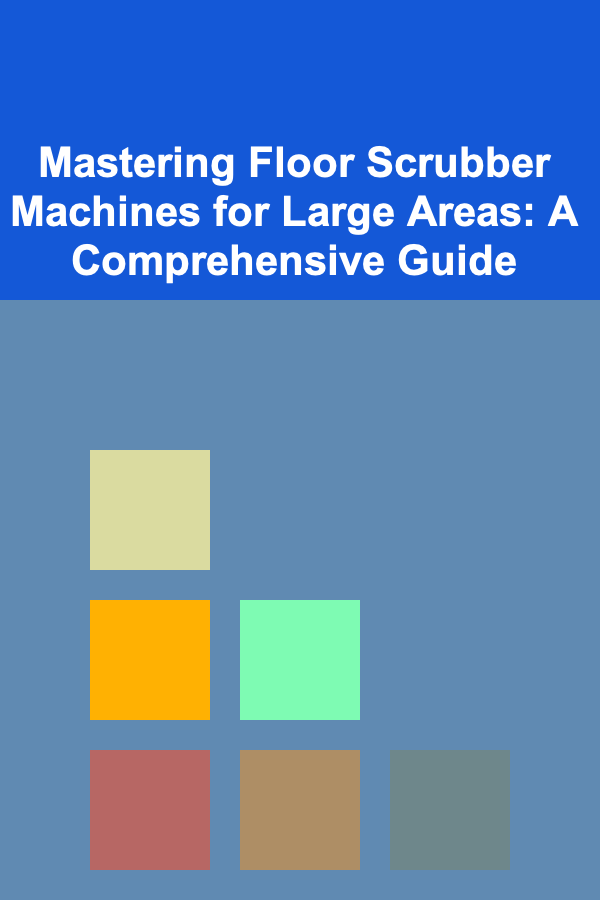
Mastering Floor Scrubber Machines for Large Areas: A Comprehensive Guide
ebook include PDF & Audio bundle (Micro Guide)
$12.99$7.99
Limited Time Offer! Order within the next:

Introduction: The Importance of Efficient Floor Cleaning
Maintaining clean and hygienic floors in large areas like warehouses, retail stores, hospitals, schools, and manufacturing facilities is not just an aesthetic concern; it's crucial for health, safety, and operational efficiency. Dirty floors can harbor bacteria, contribute to slip-and-fall accidents, and project a negative image to customers and employees. Manual cleaning methods, while sometimes necessary for spot cleaning, are often inadequate and inefficient for tackling the scale of these large spaces. This is where floor scrubber machines come into play. They represent a significant investment in efficiency, effectiveness, and long-term cost savings.
Floor scrubber machines are designed to automate the cleaning process, significantly reducing the time and labor required compared to traditional mopping. They dispense cleaning solution, scrub the floor surface, and then vacuum up the dirty water, leaving behind a clean, dry, and safe floor. However, simply possessing a floor scrubber machine isn't enough to guarantee optimal results. Proper operation, maintenance, and understanding of various factors like floor type, soiling level, and machine settings are all critical for achieving the best possible cleaning performance and maximizing the lifespan of the equipment.
This comprehensive guide aims to provide in-depth knowledge and practical advice on effectively using floor scrubber machines for large areas. We will cover everything from selecting the right type of machine to proper pre-cleaning procedures, operating techniques, and essential maintenance tips. By following these guidelines, you can ensure your floors are consistently clean, safe, and well-maintained, contributing to a healthier and more productive environment.
Choosing the Right Floor Scrubber Machine
Selecting the appropriate floor scrubber machine is the first crucial step. The ideal machine depends on several factors, including the size of the area to be cleaned, the type of flooring, the nature and intensity of soiling, and budget considerations. Here's a breakdown of key considerations:
Type of Scrubber Machine:
- Walk-Behind Scrubbers: These are the most common type for medium to large areas. They are maneuverable, relatively easy to operate, and come in various sizes.
- Disc Scrubbers: Use rotating disc brushes to scrub the floor. They are generally suitable for smooth surfaces and can effectively remove general dirt and grime.
- Cylindrical Scrubbers: Employ rotating cylindrical brushes. These are more effective on textured floors, grout lines, and can pick up loose debris simultaneously.
- Ride-On Scrubbers: Designed for very large areas where covering ground quickly is essential. They offer greater operator comfort and efficiency for cleaning vast spaces like warehouses and distribution centers. They come in various sizes and with disc or cylindrical brushes.
- Automatic Scrubbers: This refers to the mechanism where the machine automatically dispenses the solution, scrubs, and then vacuums the dirty water, as opposed to separate manual steps. Both Walk-Behind and Ride-On Scrubbers are typically automatic.
- Sweeper-Scrubbers: Combine sweeping and scrubbing functions in a single machine. These are ideal for areas with a significant amount of loose debris, reducing the need for pre-sweeping.
Key Specifications to Consider:
- Scrubbing Width: The width of the area cleaned in a single pass. A wider scrubbing width means faster cleaning but may limit maneuverability in tight spaces. Consider door widths and aisle sizes.
- Tank Capacity (Solution and Recovery): Larger tanks mean less frequent refilling and emptying, increasing cleaning efficiency. However, larger tanks also add to the machine's weight and size.
- Brush Pressure: Adjustable brush pressure allows you to tailor the cleaning intensity to the specific floor type and soiling level. Delicate floors require lower pressure.
- Brush Speed (RPM): Higher RPMs provide more aggressive scrubbing action.
- Vacuum Motor Power: A more powerful vacuum motor results in better water recovery and drier floors, reducing the risk of slip-and-fall accidents.
- Battery Life (for Battery-Powered Machines): Sufficient battery life is crucial for covering large areas without interruption. Consider the charging time as well. Lithium-ion batteries are often preferable for longer life and faster charging.
- Power Source: Battery-powered scrubbers offer greater flexibility and maneuverability, while corded electric scrubbers provide continuous power but are limited by cord length. Propane-powered scrubbers are suitable for very large, open areas but require proper ventilation.
- Noise Level: Consider noise levels, especially in noise-sensitive environments like hospitals or schools. Look for models with noise reduction features.
Floor Type and Soiling:
- Concrete: Concrete floors, especially those in industrial settings, often require aggressive scrubbing and durable brushes. Consider a heavy-duty scrubber with a cylindrical brush or a diamond-impregnated pad for polishing.
- Tile: Tile floors require a balance between effective cleaning and avoiding damage to the grout lines. Choose a scrubber with adjustable brush pressure and a brush designed for tile and grout.
- Vinyl/Linoleum: These floors are more susceptible to damage from harsh chemicals and abrasive brushes. Opt for a scrubber with gentle brushes and neutral pH cleaning solutions.
- Epoxy: Epoxy floors are generally durable but can be scratched by abrasive brushes. Use a soft brush or pad and a neutral pH cleaner.
- Heavily Soiled Areas: Areas with heavy grease, oil, or other stubborn stains may require a scrubber with higher brush pressure, a more aggressive brush, and a specialized cleaning solution.
Other Considerations:
- Operator Training: Ensure that all operators are properly trained on the machine's operation, safety features, and maintenance procedures.
- Service and Support: Choose a manufacturer or supplier with a reliable service and support network. Regular maintenance and timely repairs are essential for maximizing the lifespan of the machine.
- Budget: Consider the initial cost of the machine, as well as the ongoing costs of supplies (brushes, pads, cleaning solutions) and maintenance.
- Maneuverability: Assess the layout of the area to be cleaned and choose a machine that can easily navigate obstacles, tight corners, and narrow aisles.
Pre-Cleaning Preparation: Laying the Groundwork for Success
Effective floor scrubbing starts well before the machine is turned on. Proper pre-cleaning preparation is essential for maximizing the efficiency of the scrubber and achieving optimal cleaning results. It involves removing loose debris, addressing heavily soiled areas, and preparing the cleaning solution.
Removing Loose Debris:
- Sweeping or Vacuuming: The first step is to remove all loose debris from the floor. This includes dust, dirt, gravel, and any other materials that could clog the scrubber or damage the brushes. A sweeper or vacuum cleaner is typically used for this purpose. In some cases, a sweeper-scrubber can handle this task.
- Addressing Large Objects: Remove any large objects, such as boxes, pallets, or equipment, from the area to be cleaned. This will allow the scrubber to operate freely and efficiently.
- Floor Mats and Rugs: Remove any floor mats or rugs from the area. These can be cleaned separately.
Addressing Heavily Soiled Areas:
- Pre-Treating Stains: For areas with stubborn stains, such as grease, oil, or ink, pre-treating with a specialized cleaning solution can significantly improve the effectiveness of the scrubber. Apply the pre-treatment solution according to the manufacturer's instructions and allow it to dwell for the recommended time.
- Spot Cleaning: For small, heavily soiled areas, spot cleaning with a manual scrubber or brush may be necessary before using the machine.
- Removing Gum or Sticky Substances: Use a scraper to remove gum or other sticky substances before scrubbing. Specialized gum removal products can also be used.
Preparing the Cleaning Solution:
- Choosing the Right Cleaning Solution: Select a cleaning solution that is appropriate for the floor type and the type of soiling. Follow the manufacturer's recommendations for dilution ratios. Using the wrong cleaning solution can damage the floor or reduce the effectiveness of the scrubber. Consider using a neutral pH cleaner unless a specific problem (e.g. grease) requires something stronger.
- Dilution Ratios: Proper dilution is crucial for achieving optimal cleaning results and preventing damage to the floor. Too much cleaning solution can leave a residue, while too little may not be effective at removing dirt and grime. Use an automated dilution system if available.
- Water Temperature: In general, warm water is more effective at dissolving dirt and grime than cold water. However, be sure to check the manufacturer's recommendations for the cleaning solution and the floor type. Some floors may be damaged by hot water.
- Filling the Solution Tank: Fill the solution tank with the prepared cleaning solution according to the manufacturer's instructions. Avoid overfilling the tank.
Inspecting the Machine:
- Check Brush Condition: Ensure brushes or pads are in good condition and correctly installed. Replace worn or damaged brushes or pads.
- Check Squeegee Condition: Inspect the squeegee blades for wear or damage. Replace worn or damaged squeegee blades to ensure proper water recovery.
- Check Hoses and Connections: Check all hoses and connections for leaks or damage. Repair or replace any damaged components.
- Check Battery Charge: If using a battery-powered scrubber, ensure that the battery is fully charged.
Operating the Floor Scrubber Machine: Best Practices for Efficient Cleaning
Once the pre-cleaning preparation is complete, you are ready to operate the floor scrubber machine. Following these best practices will ensure efficient cleaning and optimal results.
Starting the Machine:
- Safety Check: Before starting the machine, perform a safety check to ensure that there are no obstructions in the area and that the machine is operating properly.
- Starting Procedure: Follow the manufacturer's instructions for starting the machine. This typically involves turning on the power switch, adjusting the brush pressure and water flow, and engaging the drive mechanism.
- Initial Test: Perform a short test run on a small, inconspicuous area to ensure that the machine is operating properly and that the cleaning solution is not damaging the floor.
Cleaning Techniques:
- Overlapping Passes: Make overlapping passes to ensure complete coverage and prevent streaking. Overlap each pass by approximately 2-3 inches.
- Consistent Speed: Maintain a consistent speed while operating the machine. Moving too quickly will reduce the effectiveness of the scrubbing action, while moving too slowly can leave streaks.
- Turning and Maneuvering: Use smooth, controlled movements when turning and maneuvering the machine. Avoid sharp turns or sudden stops, which can damage the floor or the machine.
- Adjusting Water Flow: Adjust the water flow as needed based on the level of soiling. Heavily soiled areas may require more water, while lightly soiled areas may require less.
- Monitoring Water Recovery: Monitor the water recovery to ensure that the vacuum is functioning properly. If the vacuum is not recovering water effectively, check the squeegee blades, hoses, and vacuum motor.
- Edge Cleaning: Pay special attention to edges and corners, which can be difficult to reach with the machine. Use a manual brush or edge cleaning attachment to clean these areas. Some machines have edge scrubbing features.
- Cleaning Around Obstacles: Carefully maneuver the machine around obstacles, such as tables, chairs, and equipment. Use a manual brush or cloth to clean around these obstacles if necessary.
- One-Pass Cleaning: Aim for one-pass cleaning whenever possible. This minimizes the risk of streaks and reduces the amount of time required to clean the floor. If a second pass is needed, ensure the first pass has fully dried before proceeding.
Addressing Difficult Areas:
- Grease and Oil: For areas with heavy grease or oil, use a degreasing solution and allow it to dwell for the recommended time before scrubbing.
- Stubborn Stains: For stubborn stains, use a specialized stain remover and allow it to dwell for the recommended time before scrubbing.
- Grout Lines: For grout lines, use a grout brush or attachment to scrub the grout thoroughly.
Safety Precautions:
- Wear Appropriate Personal Protective Equipment (PPE): Wear appropriate PPE, such as gloves, safety glasses, and non-slip shoes, to protect yourself from chemicals and hazards.
- Wet Floor Signs: Place wet floor signs in the area being cleaned to warn people of the potential slip hazard.
- Proper Ventilation: Ensure proper ventilation in the area being cleaned, especially when using cleaning solutions with strong odors.
- Electrical Safety: Use caution when operating electric scrubbers near water. Ensure that the power cord is in good condition and that the outlet is properly grounded.
- Machine Safety Features: Familiarize yourself with the machine's safety features, such as the emergency stop button and the safety interlocks.
Optimizing for Large Areas:
- Planning the Route: Plan the cleaning route in advance to minimize backtracking and maximize efficiency. Consider the layout of the area and the location of obstacles.
- Using Multiple Machines: For very large areas, consider using multiple scrubber machines to reduce the cleaning time.
- Teamwork: Assign tasks to different team members to streamline the cleaning process. For example, one person can operate the scrubber machine, while another person can remove obstacles and spot clean.
- Scheduling: Schedule cleaning during off-peak hours to minimize disruption to operations.
Post-Cleaning Procedures: Ensuring a Lasting Clean and Protecting Your Investment
The cleaning process doesn't end when the floor scrubber is switched off. Proper post-cleaning procedures are essential for ensuring a lasting clean and protecting your investment in the equipment.
Emptying and Cleaning the Tanks:
- Emptying the Recovery Tank: Empty the recovery tank into a designated drain or waste disposal area. Follow all local regulations for the disposal of wastewater.
- Rinsing the Recovery Tank: Rinse the recovery tank thoroughly with clean water to remove any remaining dirt or debris.
- Emptying the Solution Tank: If any cleaning solution remains in the solution tank, empty it into a designated container.
- Rinsing the Solution Tank: Rinse the solution tank with clean water to prevent the buildup of residue.
Cleaning the Machine:
- Cleaning the Brushes or Pads: Remove the brushes or pads and clean them thoroughly with soap and water. Rinse them well and allow them to air dry. Replace brushes or pads when they are worn or damaged.
- Cleaning the Squeegee Blades: Remove the squeegee blades and clean them with soap and water. Rinse them well and check for any damage. Replace squeegee blades when they are worn or damaged.
- Wiping Down the Machine: Wipe down the exterior of the machine with a damp cloth to remove any dirt or grime.
- Cleaning the Vacuum Filter: Clean the vacuum filter regularly to maintain optimal suction. Refer to the manufacturer's instructions for cleaning the filter.
Storing the Machine:
- Choosing a Storage Location: Store the machine in a clean, dry, and secure location. Avoid storing the machine in direct sunlight or extreme temperatures.
- Positioning the Machine: Position the machine in a way that prevents damage to the brushes, squeegee blades, or other components.
- Disconnecting the Battery (if applicable): If storing the machine for an extended period, disconnect the battery to prevent it from draining.
- Covering the Machine: Cover the machine with a dust cover to protect it from dirt and debris.
Inspecting the Floor:
- Checking for Streaks or Residue: Inspect the floor for any streaks or residue. If any are present, re-scrub the area.
- Checking for Damage: Inspect the floor for any damage caused by the scrubber machine. If any damage is present, repair it as soon as possible.
- Evaluating the Overall Cleanliness: Evaluate the overall cleanliness of the floor. If the floor is not as clean as desired, adjust the cleaning procedures as needed.
Documenting the Cleaning Process:
- Maintaining a Cleaning Log: Maintain a cleaning log to track the date, time, and duration of each cleaning session.
- Recording Any Problems or Issues: Record any problems or issues encountered during the cleaning process, such as machine malfunctions or difficult stains.
- Tracking Maintenance Activities: Track all maintenance activities performed on the machine, such as brush replacements and squeegee blade replacements.
Preventative Maintenance: Ensuring Longevity and Optimal Performance
Regular preventative maintenance is essential for ensuring the longevity and optimal performance of your floor scrubber machine. Following a consistent maintenance schedule will help prevent breakdowns, reduce repair costs, and extend the lifespan of the equipment.
Daily Maintenance:
- Inspect the Machine: Inspect the machine for any signs of damage or wear.
- Clean the Brushes or Pads: Clean the brushes or pads thoroughly after each use.
- Clean the Squeegee Blades: Clean the squeegee blades thoroughly after each use.
- Empty and Clean the Tanks: Empty and clean the solution and recovery tanks after each use.
- Charge the Battery (if applicable): Charge the battery after each use.
Weekly Maintenance:
- Inspect the Hoses and Connections: Inspect the hoses and connections for leaks or damage.
- Check the Brush Pressure: Check the brush pressure and adjust as needed.
- Check the Vacuum Motor: Check the vacuum motor for proper operation.
- Clean the Vacuum Filter: Clean the vacuum filter.
- Lubricate Moving Parts: Lubricate moving parts as recommended by the manufacturer.
Monthly Maintenance:
- Inspect the Drive Mechanism: Inspect the drive mechanism for wear or damage.
- Check the Belts and Pulleys: Check the belts and pulleys for wear or damage.
- Inspect the Electrical Wiring: Inspect the electrical wiring for damage or corrosion.
- Clean the Machine Thoroughly: Clean the entire machine thoroughly, including the frame, wheels, and control panel.
Annual Maintenance:
- Have the Machine Serviced by a Qualified Technician: Have the machine serviced by a qualified technician at least once a year. The technician should perform a comprehensive inspection of the machine and replace any worn or damaged parts.
- Check and Replace Batteries (if applicable): Battery life diminishes over time. Check and replace batteries according to manufacturer recommendations.
Troubleshooting Common Problems:
- Streaking: Streaking can be caused by worn squeegee blades, improper water flow, or dirty floors.
- Poor Water Recovery: Poor water recovery can be caused by worn squeegee blades, clogged hoses, or a weak vacuum motor.
- Reduced Scrubbing Power: Reduced scrubbing power can be caused by worn brushes or pads, low brush pressure, or a weak motor.
- Machine Not Starting: A machine that won't start can be caused by a dead battery, a blown fuse, or a faulty switch.
By following a consistent preventative maintenance schedule and addressing problems promptly, you can ensure that your floor scrubber machine operates efficiently and reliably for many years to come.
Conclusion: Investing in Cleanliness and Efficiency
Using floor scrubber machines effectively in large areas is an investment in cleanliness, efficiency, and the overall well-being of your facility. By understanding the different types of machines, implementing proper pre-cleaning procedures, mastering operating techniques, and adhering to a consistent maintenance schedule, you can achieve consistently clean, safe, and well-maintained floors. This, in turn, contributes to a healthier, more productive environment for your employees and a more positive image for your customers. Remember that proper training for operators is paramount, and consulting with a reputable supplier can provide valuable guidance in selecting the right machine and developing a customized cleaning plan. Embrace the power of automated floor cleaning and reap the long-term benefits of a sparkling clean and hygienic facility.
Reading More From Our Other Websites
- [Home Soundproofing 101] How to Soundproof Noisy Pipes and Reduce Water Noise in Your Home
- [Trail Running Tip 101] From Pavement to Paths: Embracing a New Beginning Through Trail Running
- [Home Security 101] How to Prepare Your Home for an Out-of-Town Trip: Security Measures You Shouldn't Skip
- [Personal Financial Planning 101] How to Budget for Major Life Events like Weddings and Children
- [Personal Care Tips 101] How to Choose a Concealer for Dry Skin to Avoid Flakiness
- [Personal Care Tips 101] How to Implement Daily Hydration for Enhanced Personal Care
- [Home Space Saving 101] How to Maximize Your Bathroom Storage
- [Organization Tip 101] How to Incorporate Vintage Furniture into Modern Spaces
- [Organization Tip 101] Why Organizing Craft Supplies Boosts Creativity and Fun
- [Paragliding Tip 101] Best Eco‑Friendly Paragliding Gear Brands Committed to Sustainable Materials

Effective Strategies for Reducing Home Clutter and Creating More Space
Read More
How to Clean Your Air Vents and Improve Air Quality
Read More
How to Protect Your Home from Fire and Carbon Monoxide Hazards
Read More
What Are the Top Strategies for Organizing Your Garage Tools?
Read More
How to Tune Your Recurve Bow for Optimal Performance
Read More
How to Curate a Thoughtful Gift Box: A Step-by-Step Guide
Read MoreOther Products

Effective Strategies for Reducing Home Clutter and Creating More Space
Read More
How to Clean Your Air Vents and Improve Air Quality
Read More
How to Protect Your Home from Fire and Carbon Monoxide Hazards
Read More
What Are the Top Strategies for Organizing Your Garage Tools?
Read More
How to Tune Your Recurve Bow for Optimal Performance
Read More